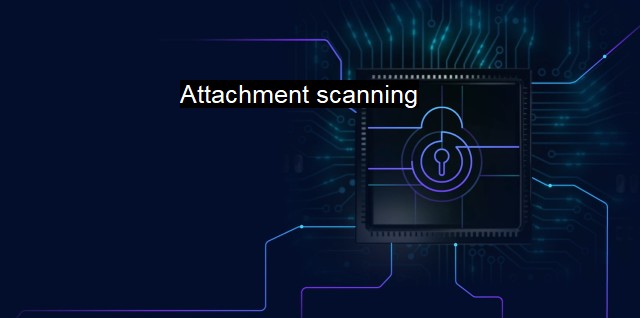What is Attachment scanning?
The Importance of Attachment Scanning in Antivirus Software: Protecting Sensitive Data and Preventing Malware Threats in Today's Digital Age
Attachment scanning is a cybersecurity method primarily used in detecting security threats in incoming and outgoing files or documents, typically within emails. Its overall function underscores the role of antivirus software, working tirelessly to protect systems and data from possible infiltration and corruption by various forms of malware.In the online realm, most communication and data exchange happen through emails and complaints. Consequently, this has made them the perfect medium for cybercriminals to deploy their malicious activities. They often use file attachments to write and hide malicious codes which, upon being opened or downloaded by the recipient, can trigger events leading to a significant data security breach.
Through attachment scanning, individual or multiple files that are included in an email or shared through a cloud storage service can be inspected and verified for any potential risks. This technique helps in the early detection of possible threats such as viruses, Trojans, spyware, ransomware, and phishing attacks, which are regularly sent to random or particular targets.
One main advantage of attachment scanning is that it sifts through the file or files without having to open them. This method lowers any potential threats, as it prevents the automatic triggering of the malicious code hidden in the file. To carry out this task, the antivirus software uses several detection methods, with the most common ones being signature-based and behavior-based detections.
Signature-based detection analyzes the files for known malware signatures, which are distinctive codes taken from previously identified and catalogued malware. Once the software finds a match, it alerts the system of a potential threat, separating the file for further review or deletion. On the other hand, behavior-based detection anticipates unknown threats by observing the file's actions and behavior. If this appears fishy and falls under the known suspicious behavior parameters, the file may be a malware and is immediately flagged.
Although these detection methods generally provide a powerful array of defense mechanisms, threat actors are continually developing advanced malware that are detection-evading. This situation calls for frequent software updates to ensure that the antivirus software has the latest catalogued malware signatures and suspicious behavior rules.
Sandboxing is another attachment scanning method that is even more comprehensive. This process involves opening the file in a controlled, isolated environment or "sandbox" to observe the file's behavior while executing. If it shows uncommon behavior or attempts to modify, delete or encrypt files, the attachment is deemed malicious. Even though sandboxing carries more process intensity, it is particularly suitable for detecting and handling unknown or sophisticated threats, thereby increasing the overall defense level.
In the larger cybersecurity outlook, attachment scanning forms a vital part of the layered security strategy also known as defense in depth. By integrating multiple protection layers, organizations have more opportunities to spot and neutralize potential threats. Hence, if a threat bypasses one layer, other controls may still potentially detect and stop it, preventing a security breach from happening.
Conclusively, attachment scanning involves an underrated but genuinely potent arsenal in managing cybersecurity risks. While not foolproof, it makes getting past system defenses a harder task for cybercriminals, varying equally in safety protection efficiency. Regardless, users should also uphold conscious and creative cybersecurity habits, like strong password practices and dubious email awareness, to complement technology's power in maintaining a secure and protected cyberspace.

Attachment scanning FAQs
What is attachment scanning?
Attachment scanning is a cybersecurity measure used to scan email attachments for malware, viruses, or other malicious payloads. The scanning process is performed by antivirus software that inspects the attachment before it is downloaded or opened by the recipient.Why is attachment scanning important?
Attachment scanning is important because email is a common method used by cybercriminals to distribute malware and other malicious payloads. Attachment scanning helps to prevent the spread of malware and viruses by detecting and removing malicious attachments before they can infect a system.What types of attachments are typically scanned for malware?
Attachment scanning typically scans all types of attachments, including Microsoft Office documents, PDFs, compressed files, images, and executable files.Can attachment scanning prevent all cyber attacks?
While attachment scanning is an important cybersecurity measure, it cannot prevent all cyber attacks. Cybercriminals are continually developing new methods to bypass antivirus software and malicious attachments can sometimes be disguised or obfuscated in a way that makes them difficult to detect. Therefore, businesses and individuals should use multiple layers of cybersecurity measures, including attachment scanning, to minimize their risk of a cyber attack.| | A | | | B | | | C | | | D | | | E | | | F | | | G | | | H | | | I | | | J | | | K | | | L | | | M | |
| | N | | | O | | | P | | | Q | | | R | | | S | | | T | | | U | | | V | | | W | | | X | | | Y | | | Z | |
| | 1 | | | 2 | | | 3 | | | 4 | | | 7 | | | 8 | | |||||||